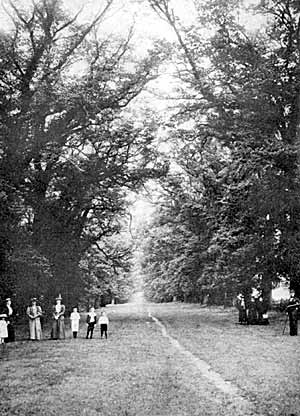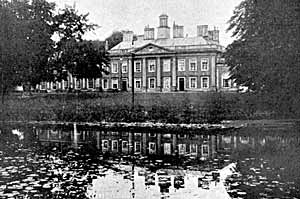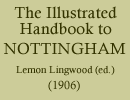< Previous | Contents | Next >
Chapter IX.
The suburbs of Nottingham and places within a short distance.
JUST across the Trent Bridge, at the end of Arkwright Street, lies the residential suburb of West Bridgford, beyond the Nottingham City limits. It has a separate Urban Council, and now contains 10,000 inhabitants, which large population, except a few hundreds, has been the growth of the last twenty-five years. The County Cricket Ground is here situated, and many have been the hard-fought games that have been decided upon it. Here were wont to play Richard Daft and Arthur Shrewsbury, each in his day the best professional batsman in England. County Football is played on the same ground, while the Nottingham Forest Football Club utilises an adjoining piece of land. St. Giles' Church is worth a visit. The fine Perpendicular nave was built about 1898 to accommodate the rapidly growing population, while the old church was incorporated as the south aisle of the new edifice.
Radcliffe-on-Trent.
(Six miles from Nottingham.) By taking the first road to the left immediately over Trent Bridge, then over the canal bridge (Lady Bay Bridge), we come into Trent Boulevard, a newly laid out part of Bridgford. This will take us a beautiful drive or walk past Holme Pierrepont Hall and Church, through Earl Manvers' park. Shortly afterwards, we reach the pleasant village of Radcliffe-on-Trent, much frequented by Nottingham holiday folk on account of the pleasant walks by the river. We can return to Nottingham by train (Great Northern Railway) or by the high road from Grantham.
Ruddington.
(Five miles by road, three and a half from Trent Bridge, or train by Great Central.) If we keep the high road (Loughborough turnpike), past the branch road to Melton Mowbray (nineteen miles), we shall soon find ourselves climbing the stiff hill to Ruddington. Looking back when we get to the sharp turn to the right, we obtain a splendid panoramic view of Nottingham and the neighbouring country. A mile or so beyond the crest of the hill we leave the main road, turning to the right for Ruddington village. The church is interesting. The making of the railway has brought a good many Nottingham people here to live. Clifton and Wilford may be taken on the way home without unduly prolonging the round.
Clifton.

Clifton Grove.
(Two and three-quarter miles from Nottingham by road. Two miles' walk by taking tram to Wilford Bridge.) Charming old-time Clifton, with ample "village Green" and thatched cottages, loved by successive generations of Nottingham people as the scene of many of Kirke White's poetic fancies.
"Dear Native Grove! where'er my devious track,
To thee will Memory lead the wanderer back."
The church contains some monuments of the Clifton family. The Hall is at present tenanted by Colonel Bruce. The walk through the famous Clifton Grove begins near the church and stretches a short mile in the direction of Wilford, occupying a high bank under the shade of magnificent trees.
"Stilled is the village hum—the woodland sounds Have ceased to echo o'er the dewy grounds,
And general silence reigns, save when below
The murmuring Trent is scarcely heard to flow.'
Wilford may be seen driving home from Clifton, or if we start from Nottingham, we take the tram to the end of Wilford Road, and then the village is only a few minutes' walk. Like Clifton, it is a rural old-world spot, unspoiled by modern building operations. A medallion portrait of Kirke White has been placed in the Parish Church, but the poet lies buried, not here, but at Cambridge.
Colwick Hall and Grounds.

Colwick Hall.

Colwick weir.
(About one mile from Trent Bridge by boat. Station, Netherfield, Great Northern; or by road, two miles from Nottingham.) Once the home of the Chaworth-Musters family, Colwick Park is now turned into a race-course, where several meetings are held yearly, and the hall and garden are devoted to the entertainment of sight-seers. Mary Chaworth, to whom Byron was attached in early youth (see poem, The Dream), married Mr. John Musters of Colwick in 1805. She died in 1832, eight years after the poet. In Colwick Church are monuments of several of Byron's ancestors, and a beautiful alabaster tomb to the memory of Mary Chaworth.
Gotham.
(Seven miles from Nottingham; three miles from Trent Station, Mid., or East Leake, G.C.R.). Who has not heard of the "Wise Men of Gotham"? The Merry Tales of the Mad Men of Gotham, is a Jest Book as old as the days of Henry VIII. There is nothing very interesting in the village itself, but it is surrounded by beautiful country, and several interesting excursions may be made in this direction. Gypsum is worked here, as at several places in this part of the Trent Valley. Sceptical people have doubted the tale about the cuckoo, which the men of Gotham penned up by a hedge, but here is a veritable inn with a sign, "The Cuckoo Bush," to prove it!
Wollaton Hall.
(two miles from Nottingham by road, half-mile from tramway at Lenton) is the country seat of Lord Middleton, the head of the ancient Willoughby family. A street in the neighbouring suburb of Lenton and a house on The Pavement (once the "town" house of the family) bear the name of Willoughby. We enter by the grey castellated lodge on the Derby Road, and make our way through a splendid avenue of trees, with the extensive park on all sides. The present mansion was built, as an inscription testifies, in 1580-8, and is a beautiful Elizabethan house of Ancaster stone. It exemplifies the best type of English domestic architecture, being coeval with Hatfield and Burleigh. But Wollaton has features of its own, such as the massive central tower with mediaeval angle turrets, around which are four smaller towers, finished with ornamental gables and united together by the main building. The walls are everywhere relieved and strengthened by pillars, which greatly improve the general effect. The house contains a number of art treasures, e.g. paintings by Rubens, Kneller, Reynolds, Heemskerk, etc. Wollaton Church, containing monuments to the Willoughby family, is in Wollaton village, on the Ilkeston Road, and may be visited along with the hall by continuing on the Derby Road to Bramcote, thence past the "Hemlock Stone," a drive of about six miles. (For permission to see the house apply to Lord Middleton's Agent, Wollaton.)
Attenborough, Barton, and Thrumpton (seven miles), are much frequented on account of their proximity to the river and for the pleasure of a rural walk followed by tea at a cottage. Attenborough may be reached by train (Midland). It is famous as the birthplace of General Ireton (see p. 101), and is in itself a pretty place. The church is interesting. From Attenborough we may cross the Trent by ferry-boat to Barton, where tea can be obtained, or we may walk along the bank to Thrumpton, another favourite "tea" resort. Return from Trent Station (Midland). The round may be done by cycle as pointed out in Route No. iii., Chapter XV.
